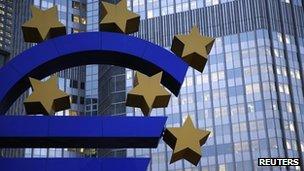Eurozone unemployment falls for first time since 2011
- Published

The ECB thinks an inflation rate of just under 2% is ideal for economic growth
The eurozone's unemployment rate has fallen for the first time since early 2011, according to official data.
The jobless rate across the 17 countries using the euro currency fell to 12.1% in October, the first fall since February 2011, the European Union's statistics office Eurostat said.
About 19 million people are out of work across the region.
Meanwhile, the annual rate of consumer inflation rose from 0.7% to 0.9%.
The European Central Bank (ECB) aims to keep inflation just below 2% - the level it deems right for growth.
The data indicates that the fragile eurozone economy may be gradually improving, although there are big disparities between individual countries.
The unemployment rate in Spain and Greece is about 27%, for example, while Austria's is 5%.
Anaemic growth
In a surprise move earlier this month, the ECB cut its benchmark interest rate from 0.5% to a record low of 0.25%.
ECB president Mario Draghi said the decision reflected its view that low inflation and weak economic growth would be the dominant story in the region.
When eurozone inflation fell to 0.7% in October - its lowest level since January 2010 - there were fears that growth could be stalling and that some countries could even be moving into deflation.
This latest rise in inflation has led some economists to think the ECB will not have reduce interest rates further in the near future.
Frederik Ducrozet, an economist at Credit Agricole bank, said that it "should buy the ECB more time to decide whether or not to provide more accommodation".
But the eurozone economy remains anaemic, growing 0.3% in the second quarter and just 0.1% in the third. The European Commission has forecast growth of 1.1% for 2014 and 1.7% for 2015.
- Published29 November 2013
- Published21 November 2013
- Published21 November 2013
- Published14 November 2013
- Published7 November 2013